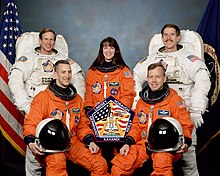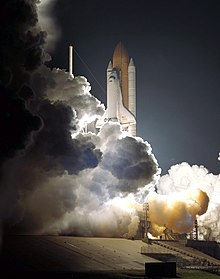 Quest being grappled by Canadarm2, prior to its installation on the ISS Quest being grappled by Canadarm2, prior to its installation on the ISS | |
| Names | Space Transportation System-104 |
|---|---|
| Mission type | ISS assembly |
| Operator | NASA |
| COSPAR ID | 2001-028A |
| SATCAT no. | 26862 |
| Mission duration | 12 days, 18 hours, 36 minutes, 39 seconds |
| Distance travelled | 8,500,000 kilometres (5,300,000 mi) |
| Orbits completed | 200 |
| Spacecraft properties | |
| Spacecraft | Space Shuttle Atlantis |
| Launch mass | 117,129 kilograms (258,225 lb) |
| Landing mass | 94,009 kilograms (207,254 lb) |
| Payload mass | 8,241 kilograms (18,168 lb) |
| Crew | |
| Crew size | 5 |
| Members | |
| EVAs | 3 |
| EVA duration | 16 hours, 30 minutes |
| Start of mission | |
| Launch date | 12 July 2001, 09:04 (2001-07-12UTC09:04Z) UTC |
| Launch site | Kennedy, LC-39B |
| End of mission | |
| Landing date | 25 July 2001, 03:38 (2001-07-25UTC03:39Z) UTC |
| Landing site | Kennedy, SLF Runway 15 |
| Orbital parameters | |
| Reference system | Geocentric |
| Regime | Low Earth |
| Perigee altitude | 372 kilometres (231 mi) |
| Apogee altitude | 390 kilometres (240 mi) |
| Inclination | 51.6 degrees |
| Period | 92.2 minutes |
| Docking with ISS | |
| Docking port | PMA-2 (Destiny forward) |
| Docking date | 14 July 2001 03:08 UTC |
| Undocking date | 22 July 2001 04:54 UTC |
| Time docked | 8 days, 1 hour, 46 minutes |

 Left to right: Seated - Charles O. Hobaugh, Steven W. Lindsey; Standing - Michael L. Gernhardt, Janet L. Kavandi, James F. ReillySpace Shuttle program← STS-100STS-105 → | |
STS-104 was a Space Shuttle mission to the International Space Station (ISS) flown by Space Shuttle Atlantis. Its primary objectives were to install the Quest Joint Airlock and help perform maintenance on the International Space Station. It launched on 12 July 2001 at 09:04 UTC, and returned to Earth without incident after successful docking, equipment installation, and three spacewalks.
Crew
| Position | Astronaut | |
|---|---|---|
| Commander | Steven W. Lindsey Third spaceflight | |
| Pilot | Charles O. Hobaugh First spaceflight | |
| Mission Specialist 1 | Michael L. Gernhardt Fourth and last spaceflight | |
| Mission Specialist 2 Flight Engineer |
Janet L. Kavandi Third and last spaceflight | |
| Mission Specialist 3 | James F. Reilly Second spaceflight | |
Crew seat assignments
| Seat | Launch | Landing |  Seats 1–4 are on the flight deck. Seats 5–7 are on the mid-deck. |
|---|---|---|---|
| 1 | Lindsey | ||
| 2 | Hobaugh | ||
| 3 | Gernhardt | Reilly | |
| 4 | Kavandi | ||
| 5 | Reilly | Gernhardt | |
| 6 | Unused | ||
| 7 | Unused | ||
Mission highlights

The primary purpose of the flight was to deliver and install the Quest airlock. The Joint Airlock is a pressurized flight element consisting of two cylindrical chambers attached end-to-end by a connecting bulkhead and hatch. Once installed and activated, the ISS airlock became the primary path for International Space Station space walk entry and departure for U.S. spacesuits, which are known as Extravehicular Mobility Units, or EMUs. In addition, the Joint Airlock is designed to support the Russian Orlan spacesuit for EVA activity.
The Joint Airlock is 20 ft (6.1 m) long, 13 ft (4.0 m) in diameter and weighs 6.5 short tons (5.9 metric tons). It is made from steel and aluminum, and manufactured at the Marshall Space Flight Center (MSFC) by the Space Station main contractor Boeing. The ISS-airlock has two main components: a crew airlock and an equipment airlock for storing EVA gear and EVA preflight preps. STS-104 also carries a spacelab pallet with four High Pressure Gas Assembly containers that were attached to the exterior of the airlock.
Mission Specialists Michael Gernhardt and James Reilly conducted three space walks while Space Shuttle Atlantis was docked to the International Space Station. They spent a total of 16 hours and 30 minutes outside. During the first space walk, Gernhardt and Reilly assisted in the installation of the airlock. During the second and third excursions, they focused on the external outfitting of the Quest airlock with four High Pressure Gas Tanks, handrails and other vital equipment. The third spacewalk was conducted from Quest itself.
STS-104 was the final Space Shuttle mission to have a five-member crew. All succeeding missions would have six or seven (except the final mission STS-135, which had 4).
First flight of Block II SSME
STS-104 was the first shuttle mission to fly with a "Block II" SSME. Post-launch analysis indicated an anomaly occurred when the engine was shut down. The cause was determined and the mitigation approach was demonstrated on the STS-108 flight in November 2001.
Space walks
- Gernhardt and Reilly – EVA 1
- EVA 1 Start: 15 July 2001 – 03:10 UTC
- EVA 1 End: 15 July 2001 – 09:09 UTC
- Duration: 5 hours, 59 minutes
- Gernhardt and Reilly – EVA 2
- EVA 2 Start: 18 July 2001 – 03:04 UTC
- EVA 2 End: 18 July 2001 – 09:33 UTC
- Duration: 6 hours, 29 minutes
- Gernhardt and Reilly – EVA 3
- EVA 3 Start: 21 July 2001 – 04:35 UTC
- EVA 3 End: 21 July 2001 – 08:37 UTC
- Duration: 4 hours, 02 minutes

Wake-up calls
NASA began a tradition of playing music to astronauts during the Gemini program, which was first used to wake up a flight crew during Apollo 15. Each track is specially chosen, often by their families, and usually has a special meaning to an individual member of the crew, or is applicable to their daily activities.
| Flight Day | Song | Artist/Composer |
|---|---|---|
| Day 2 | "Wallace Courts Murron" | Braveheart Soundtrack |
| Day 3 | "God of Wonders" | Caedmons Call |
| Day 4 | "Space Cowboy" | 'N Sync, from the soundtrack to Space Cowboys |
| Day 5 | "No Woman, No Cry" | Bob Marley |
| Day 6 | "Nobody Does It Better" | Carly Simon, from the soundtrack to The Spy Who Loved Me |
| Day 7 | "Happy Birthday, Darling" | Conway Twitty |
| Day 8 | "All I Wanna Do" | Sheryl Crow |
| Day 9 | "A Time to Dance" | Space Center Intermediate School Symphonic Band |
| Day 10 | "I Could Write a Book" | Harry Connick Jr., from the soundtrack to When Harry Met Sally... |
| Day 11 | "Who Let the Dogs Out?" | The Baha Boys |
| Day 12 | "Orinoco Flow" | Enya |
| Day 13 | "Honey, I'm Home" | Shania Twain |
| Day 14 | "Hold Back the Rain" | Duran Duran |
See also
- List of human spaceflights
- List of International Space Station spacewalks
- List of Space Shuttle missions
- List of spacewalks and moonwalks 1965–1999
- Outline of space science
References
![]() This article incorporates public domain material from websites or documents of the National Aeronautics and Space Administration.
This article incorporates public domain material from websites or documents of the National Aeronautics and Space Administration.
- "STS-104". Spacefacts. Retrieved 29 July 2024.
- "Giving the space station a doorway to space". NASA. Archived from the original on 13 August 2001.
- Greene, William D.; Kynard, Michael H.; Tiller, Bruce K. (2002). "Understanding and Resolution of the Block 2 SSME, STS-104 Engine Shutdown Pressure Surge In-Flight Anomaly". NASA Sti/Recon Technical Report N. 03. Smithsonian Astrophysical Observatory: 05846. Bibcode:2002STIN...0305846G.
- ^ Fries, Colin (25 June 2007). "Chronology of Wakeup Calls" (PDF). NASA. Archived from the original (PDF) on 5 June 2010. Retrieved 13 August 2007.
- "STS-104 Wakeup Calls". NASA. 11 May 2009. Archived from the original on 24 July 2001. Retrieved 31 July 2009.
External links
- NASA mission summary Archived 10 August 2016 at the Wayback Machine
- STS-104 Video Highlights Archived 6 October 2017 at the Wayback Machine
| Space Shuttle Atlantis (OV-104) | ||
|---|---|---|
| Completed flights |  | |
| Status |
| |
| On display | ||
| Human spaceflights to the International Space Station | ||
|---|---|---|
| See also: ISS expeditions, Uncrewed ISS flights | ||
| 1998–2004 |
|  |
| 2005–2009 | ||
| 2010–2014 | ||
| 2015–2019 |
| |
| Since 2020 |
| |
| Future | ||
| Individuals | ||
| Vehicles |
| |
| ||
| U.S. Space Shuttle missions | |||||||||||
|---|---|---|---|---|---|---|---|---|---|---|---|
| Completed (crews) |
| ||||||||||
| Cancelled | |||||||||||
| Orbiters | |||||||||||
| |||||||||||
| ← 2000Orbital launches in 20012002 → | |
|---|---|
| January , | |
| February , | |
| March , | |
| April , | |
| May , | |
| June , | |
| July , | |
| August , | |
| September , | |
| October , | |
| November , | |
| December , | |
| Launches are separated by dots ( • ), payloads by commas ( , ), multiple names for the same satellite by slashes ( / ). Crewed flights are underlined. Launch failures are marked with the † sign. Payloads deployed from other spacecraft are (enclosed in parentheses). | |
Categories: